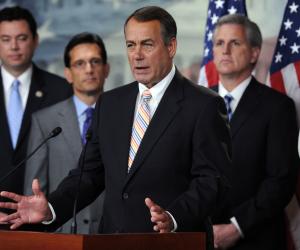When you write a constitutional amendment, the devil is in the details.
“Cut, Cap, and Balance†prescribed some details for a Balanced Budget Amendment (BBA). But those details were poorly thought-out, and might have given America a devil of a problem.
Fortunately, Senate liberals—too short-term greedy to recognize their own long-term political interest—defeated Cut, Cap, and Balance. As a result, we dodged a bullet we had unwittingly fired at ourselves.
Let me make it clear that I believe in balanced budgets, and would like to see a balanced budget requirement in the U.S. Constitution. And I’ve proved my bona fides: For many years I conspicuously led citizen efforts in Montana to limit taxes and spending—and did so at enormous personal and professional cost. However, years ago, when researching the subject of “TELs†(tax and expenditure limitations), I learned that some measures can do more harm than good. In other words, they can backfire. Whether a limitation works as intended or backfires depends largely on how you write it.
The authors of the Cut, Cap, and Balance bill were well intentioned, but in the BBA part of the bill, they made some serious mistakes.
First: The bill required that before the debt limit could be increased, Congress must propose a BBA meeting several requirements. But in doing so, the authors of the bill unwittingly invited the courts to strike down any BBA so proposed.
The problem is that the courts have held that during the Constitution’s amendment process all proposing, applying, and ratifying bodies act as “Article V assemblies†(my phrase), and not in their normal legislative capacities. Moreover, within their assigned agendas, Article V assemblies must enjoy freedom of deliberation. If the debt limit rule (adopted by Congress and the President in a legislative capacity) puts pressure on Congress (in its Article V capacity), then arguably the discretion of the proposing body has been unconstitutionally infringed. If this argument were accepted, the proposed BBA would be void. (I explain the cases in another context in this Goldwater Institute paper.)
This outcome is far from certain, but it is made more likely by the fact that the Cut, Cap, and Balance bill also sought to mandate important conditions on any such amendment.
At the least, you can bet that liberal interest groups would have sued to void any BBA proposed as a result of Cut, Cap, and Balance—and even if ultimately unsuccessful, they could have tied it up in the courts for a long time. The terms of the legislation would have given those groups a decent basis for such a lawsuit.
Second: Cut, Cap and Balance required that two-thirds of each house of Congress approve any tax increases. Depending on the size of a legislative body, the requirement of a set super-majority (such as 2/3 or 3/4) may reduce OR INCREASE taxes and spending.
Generally, in larger legislative bodies (such as Congress) high required super-majorities may actually RAISE taxes and spending as lawmakers add items of pork to a bill to get the necessary votes.  One study I’ve seen, as well as some anecdotal evidence, suggests that in bodies the size of the U.S. Senate and House of Representatives, the two-thirds level might well backfire, and that a lower supermajority (60% or even 55%) probably would be better. I’m no statistician, but in the future this issue needs to be considered thoroughly with the help of some good statisticians.
Third: Cut, Cap and Balance would have required that the BBA cap federal spending as a share of GDP. However, experience from the states suggests that in practice fixed spendingcaps tend to become spending floors.
Fourth and most seriously:Â A constitutional amendment allowing Congress to spend up to, say, 19% of GDP could concede the constitutionality of all of the thousands of federal domestic spending programs in effect when the federal government last spent under 19% of GDP (in the year 2001). Thus, programs that are now constitutionally suspect and subject to eventual court challenge could be constitutionally insulated by the amendment.
True, the courts generally uphold those programs now, due to a misunderstanding of the meaning of the Constitution’s General Welfare Clause. But over the last few years originalist legal scholars have labored to correct that problem—to explain to judges and other citizens that the General Welfare Clause is a limit on taxes rather than an authorization on spending.
A “percent of GDP†amendment could pull the rug out from under that argument, and concede the entire constitutional case to those favoring unlimited federal spending. Whether a new spending program was constitutional or not would depend only on whether it caused expenditures to exceed the cap, not on whether the subject was within Congress’s enumerated powers.
And that would be a permanent and very damaging change to the American constitutional system.
In private life, Rob Natelson is a long-time conservative/free market activist, but professionally he is a constitutional scholar whose meticulous studies of the Constitution’s original meaning have been published or cited by many top law journals. (See http://constitution.i2i.org/about/.) Most recently, he co-authored The Origins of the Necessary and Proper Clause (Cambridge University Press) and The Original Constitution (Tenth Amendment Center). After a quarter of a century as Professor of Law at the University of Montana, he recently retired to work full time at Colorado’s Independence Institute. Visit his blog there at http://constitution.i2i.org/
- Insights into the Constitution from English Social History - October 7, 2024
- More Evidence that “Direct Taxes” include Levies on Wealth and Income - July 26, 2024
- Clearing Up the Confusion About the Constitution’s Term “Direct Taxes” - July 17, 2024


